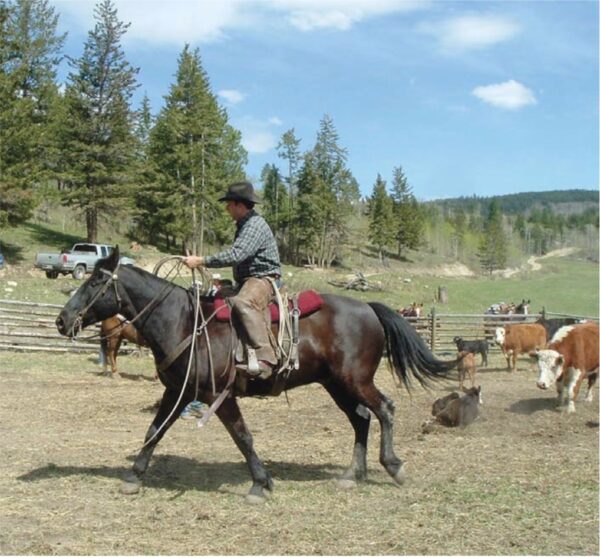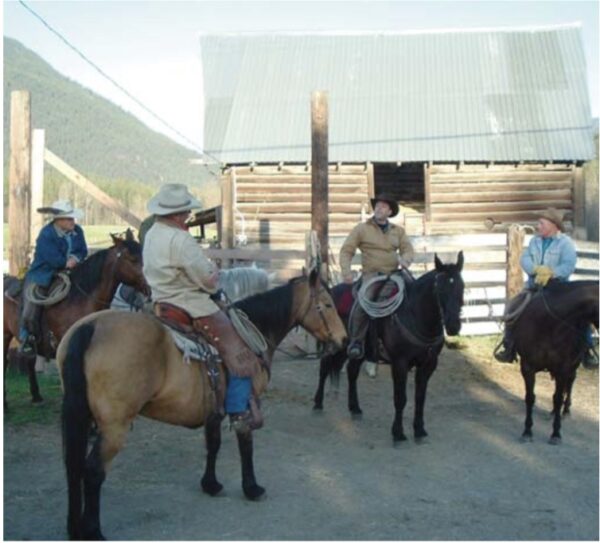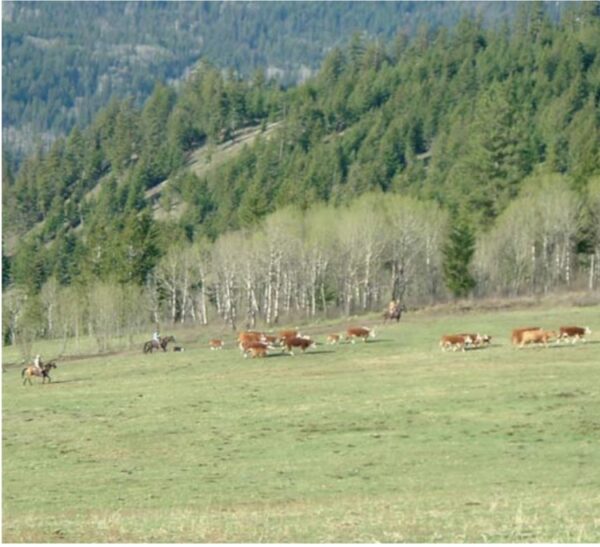Working Cowboy to Wealth Management Consultant ~ Spirit of the West by Hugh McLennan
Ol’ Sambo was wearing somebody else’s saddle and it had the look of a rig owned by a full-time working cowboy. The slick fork Wade with a well- used, 60-foot soft poly rope neatly coiled, a pair of leather hobbles hanging from one back cinch billet and a fencing plier in a leather pouch on the other bore the battle scars of some long days in rough country.
The saddle belonged to Fred Feistmann, now a successful financial planner. The ranch owner (who was also a client of Fred’s) invited him to ride with the gather and help heel calves for today’s branding. Now this rancher was mighty particular about his calves, and if he was turning a stockbroker loose in the branding pen with a 60-foot rope, this could be an interesting day.

From his well-worn chinks with several short lines neatly hung through the rings and his custom-made spurs on well-worn buckaroo boots, he had the look of someone who spends his days horseback with a crew of professional working cowboys, not someone who checks market indexes, commodity futures and thirty-day moving averages.
The rancher had offered him Sambo for the day, a solid nine-year-old black gelding. As Fred easily swung into the saddle, he showed a light touch on the reins and rode as if he was part of the horse. When we started gathering cows and calves, no one had to tell him where to be or what was going on. When we worked together in the branding pen he worked his magic with that long soft rope, slid his dallies on the slick horn and I don’t think I ever saw him miss.
“Lots of practice I guess,” Fred said, when we talked about developing that “smoothness” in every aspect of cow work. “Fred Roberson took me aside on my first cowboy job and told me to throw loops at the roping dummy every time I had a spare minute. The idea is for the calf to not even know he’s caught.” Before he passed all the necessary exams to become a licensed stockbroker and financial planner, Fred spent nine years in the cowboy crew for some of Western Canada’s biggest outfits including Douglas Lake, the Nicola Ranch and the Gang.
The initiation process for a hopeful but inexperienced young cowboy on his first job can be painful. Fred said getting bucked off was something that came with the territory but he recalled another young guy starting out at Douglas Lake. “For some reason, this poor guy got bucked off every day.” Fred recalled.
“One morning at the Minnie Lake camp he drew a tough mare called Blue Train and we all knew she would buck. Well she did and he stayed with her for several big jumps then she tossed him off onto a three rail fence, and when he came down the rails broke his fall but his fall broke all three rails! Something like this would happen to this poor guy every day.”
“A while later we were gathering in a pasture that a grass fire had burned through. This guy went out on his own wearing a brand new white hat, and when he showed up later he was covered with ash from his boots to his now soot- coloured new hat. He’d been bucked off again and couldn’t hide the evidence.”

When I asked Fred if he’d ridden for any of the big outfits in the U.S., he said the legendary Padlock Ranch called him in the spring of ’94 with a job offer. It meant being out with the wagon for the entire season and sounded great, but he wound up declining the offer.
“They said no dogs, and I had a faithful cow dog of my own, so I wound up going to work for Stan Jacobs at Minnie Lake, part of the Douglas Lake outfit instead. The closest I got to that situation, I guess was packing all my supplies into Hungry Valley at the Gang Ranch.” Fred’s eyes lit up when he recalled some of his memories of the vast Gang Ranch. “I dipped my spur in Lorna Lake, as far south as you can get on the ranch, and did it again in the Fraser River. I think that’s about a hundred miles in a straight line, which you can’t go!”
Fred credits his working cowboy background for much of the success he’s had in his present career. During those long nights calving heifers at the Nicola Ranch, he would study for his Securities Commission exams by the light of a lantern in the calving barn.

He summed up his philosophy for financial success using true cowboy logic. “Growing money’s like growing a cow herd. You’ve got to cull a few things out, you need to be prepared for good and bad calving seasons, you need an injection of new blood into the herd at times, you have to realize that it takes time and the biggest thing you can do is avoid the wrecks.”
Originally published February/March 2006 Canadian Cowboy Country Magazine












